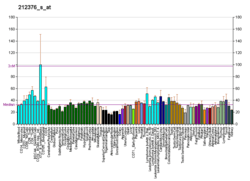References
- 1 2 3 GRCh38: Ensembl release 89: ENSG00000183495 - Ensembl, May 2017
- 1 2 3 GRCm38: Ensembl release 89: ENSMUSG00000029505 - Ensembl, May 2017
- ↑ "Human PubMed Reference:".
- ↑ "Mouse PubMed Reference:".
- ↑ Margolis RL, Abraham MR, Gatchell SB, Li SH, Kidwai AS, Breschel TS, Stine OC, Callahan C, McInnis MG, Ross CA (Jul 1997). "cDNAs with long CAG trinucleotide repeats from human brain". Hum Genet. 100 (1): 114–22. doi:10.1007/s004390050476. PMID 9225980.
- 1 2 3 4 Fuchs M, Gerber J, Drapkin R, Sif S, Ikura T, Ogryzko V, Lane WS, Nakatani Y, Livingston DM (Aug 2001). "The p400 complex is an essential E1A transformation target". Cell. 106 (3): 297–307. doi:10.1016/S0092-8674(01)00450-0. PMID 11509179.
- ↑ "Entrez Gene: EP400 E1A binding protein p400".
Further reading
- Doyon Y, Côté J (2004). "The highly conserved and multifunctional NuA4 HAT complex". Curr. Opin. Genet. Dev. 14 (2): 147–54. doi:10.1016/j.gde.2004.02.009. PMID 15196461.
- Nagase T, Kikuno R, Ishikawa K, et al. (2000). "Prediction of the coding sequences of unidentified human genes. XVII. The complete sequences of 100 new cDNA clones from brain which code for large proteins in vitro". DNA Res. 7 (2): 143–50. doi:10.1093/dnares/7.2.143. PMID 10819331.
- Nagase T, Nakayama M, Nakajima D, et al. (2001). "Prediction of the coding sequences of unidentified human genes. XX. The complete sequences of 100 new cDNA clones from brain which code for large proteins in vitro". DNA Res. 8 (2): 85–95. doi:10.1093/dnares/8.2.85. PMID 11347906.
- Nakayama M, Kikuno R, Ohara O (2003). "Protein-protein interactions between large proteins: two-hybrid screening using a functionally classified library composed of long cDNAs". Genome Res. 12 (11): 1773–84. doi:10.1101/gr.406902. PMC 187542. PMID 12421765.
- Strausberg RL, Feingold EA, Grouse LH, et al. (2003). "Generation and initial analysis of more than 15,000 full-length human and mouse cDNA sequences". Proc. Natl. Acad. Sci. U.S.A. 99 (26): 16899–903. doi:10.1073/pnas.242603899. PMC 139241. PMID 12477932.
- Cai Y, Jin J, Tomomori-Sato C, et al. (2003). "Identification of new subunits of the multiprotein mammalian TRRAP/TIP60-containing histone acetyltransferase complex". J. Biol. Chem. 278 (44): 42733–6. doi:10.1074/jbc.C300389200. PMID 12963728.
- Ota T, Suzuki Y, Nishikawa T, et al. (2004). "Complete sequencing and characterization of 21,243 full-length human cDNAs". Nat. Genet. 36 (1): 40–5. doi:10.1038/ng1285. PMID 14702039.
- Doyon Y, Selleck W, Lane WS, et al. (2004). "Structural and functional conservation of the NuA4 histone acetyltransferase complex from yeast to humans". Mol. Cell. Biol. 24 (5): 1884–96. doi:10.1128/MCB.24.5.1884-1896.2004. PMC 350560. PMID 14966270.
- Beausoleil SA, Jedrychowski M, Schwartz D, et al. (2004). "Large-scale characterization of HeLa cell nuclear phosphoproteins". Proc. Natl. Acad. Sci. U.S.A. 101 (33): 12130–5. doi:10.1073/pnas.0404720101. PMC 514446. PMID 15302935.
- Gerhard DS, Wagner L, Feingold EA, et al. (2004). "The status, quality, and expansion of the NIH full-length cDNA project: the Mammalian Gene Collection (MGC)". Genome Res. 14 (10B): 2121–7. doi:10.1101/gr.2596504. PMC 528928. PMID 15489334.
- Chan HM, Narita M, Lowe SW, Livingston DM (2005). "The p400 E1A-associated protein is a novel component of the p53 --> p21 senescence pathway". Genes Dev. 19 (2): 196–201. doi:10.1101/gad.1280205. PMC 545875. PMID 15655109.
- Samuelson AV, Narita M, Chan HM, et al. (2005). "p400 is required for E1A to promote apoptosis". J. Biol. Chem. 280 (23): 21915–23. doi:10.1074/jbc.M414564200. PMID 15741165.
- Tyteca S, Vandromme M, Legube G, et al. (2006). "Tip60 and p400 are both required for UV-induced apoptosis but play antagonistic roles in cell cycle progression". EMBO J. 25 (8): 1680–9. doi:10.1038/sj.emboj.7601066. PMC 1440826. PMID 16601686.




